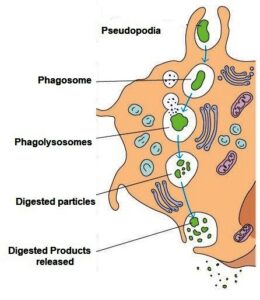Skip to content
Phagocytosis – Introduction and Mechanisms
- A significant defense mechanism of the innate system.
- Phagocytosis: Process of ingestion and digestion of the extracellular particulate material by phagocytic cells.
- Extracellular particulate includes complete microorganisms (pathogens), insoluble particles.
- Endogenous matter such as dead host cells, debris particles, and activated clotting factors are also phagocytosed.
 Phagocytosis is a type of endocytosis, and killing take place by two types of mechanisms
Phagocytosis is a type of endocytosis, and killing take place by two types of mechanisms
Phagocytic cells
- Phagocytic cells, which includes neutrophils, blood monocytes, and tissue macrophage.
 Macrophage ingesting bacteria by phagocytosis
Macrophage ingesting bacteria by phagocytosis
Steps of Phagocytosis
- Macrophage is attracted towards chemotactic factors – this process is called chemotaxis.
- Bacteria or antigens become attached to membrane evaginations (pseudopodia).
- The ingested bacterium fused with pseudopodia is enclosed in the phagosome.
- Phagosomes lead toward the cell interior and fuse with lysosomes, form phagolysosomes.
- In phagolysosomes, ingested particles are digested by lysozyme.
- Digested particle releases from the cell by exocytosis.
 Schematic Representation of the Phagocytosis
Schematic Representation of the Phagocytosis
Mechanism of Phagocytosis
- Macrophage is activated by classes of antibody-binding antigens, known as opsonins.
- Opsonins enhance the rate of phagocytosis.
- The process is called opsonization.
- Antimicrobial & Cytotoxic substances released by activated macrophage.
- Both substances have a tendency to destroy ingested microorganism
Oxygen-Dependent Killing Mechanisms
- Reactive oxygen intermediates (ROIs) & reactive nitrogen intermediates – produced by activated macrophages.
- Both reactive O2 & N2 intermediates have an effective antimicrobial effect.
- During phagocytosis, a process of respiratory burst occurs in macrophages
- In which, membrane-bound oxidase is activated
- Reduction of O2 —> catalyze ——> Superoxide anion( Reactive O2 intermediate)
- Superoxide anion generates hydroxyl radicals & hydrogen peroxide (oxidizing agents)
- In phagolysosome, the enzyme myeloperoxidase catalyze hydroperoxide and chlorine ions ——> Hypochlorite
- Hypochlorite is toxic to ingested microorganisms, therefore used in household bleach.
- Generally, the macrophage is triggered by Lipopolysaccharide(LPS)–> Component of the bacterial cell.
- For mycobacteria, muramyl dipeptide + T-cell derived cytokines (IFN-λ)—–>express nitric oxide synthetase (High levels)
- Enzyme nitric oxide synthetase —–> oxidize —–>L-arginine into—–> L-citrulline + nitric oxide (reactive N2 intermediates).
- Nitric oxide has efficient antimicrobial activity.
- Combination with superoxide ions generates more effective antimicrobial compounds.
 Activated macrophages, producing reactive O2 and N2 intermediates during oxygen-dependent killing mechanisms
Activated macrophages, producing reactive O2 and N2 intermediates during oxygen-dependent killing mechanisms
Oxygen- Independent Killing Mechanisms
- Activated macrophages produce several hydrolytic enzymes and lysozymes.
- These enzymes have degradative activity, without the involvement of oxygen.
- Additionally, a group of peptides are produced, which have antimicrobial & cytotoxic activity known as defensins.
- Cysteine-rich molecules consist of 29-35 residues of amino acids.
- Form channels in the cell membranes of the bacteria, which are ion-permeable.
- Can kill, diversity of the bacteria which includes, E.Coli, Pseudomonas aeruginosa, Staphylococcus aureus, Streptococcus pneumonia.
- Cytokine such as tumor necrosis factor (TNF-α), is released by activated macrophage
- Have cytotoxic effects on tumor cells.
 Activated macrophages release antimicrobial and cytotoxic substances during Oxygen independent killing
Activated macrophages release antimicrobial and cytotoxic substances during Oxygen independent killing
References and Sources
- https://immunologysystem.blogspot.com/2016/07/mononuclear-phagocytes.html
- https://www.researchgate.net/publication/7464252_Targeted_Drug_Delivery_to_Macrophages_in_Parasitic_Infections
- https://en.wikipedia.org/wiki/Phagocytosis
- https://www.sciencedirect.com/science/article/pii/S0005273616300311
Also Read:





